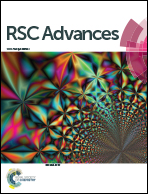Au/Ag bimetal nanogap arrays with tunable morphologies for surface-enhanced Raman scattering
Abstract
When Au and Ag were deposited onto two-dimensional polystyrene (PS) templates, a curved bimetallic film composed of nanocap-shaped Au/Ag units was formed. The “Y”-shaped nanogaps and “V”-shaped junctions were tailored between the neighbour nanocaps by changing the bilayer thickness and PS diameters. Compared to the curved Ag, the curved Au monolayer and the flat Au/Ag bilayer on a silicon wafer, the curved Au/Ag bimetallic film exhibited significant SERS enhancement, which was mainly attributed to two important factors, the nanogaps between the adjacent Au/Ag nanocaps and the composite of the Ag/Au bimetallic film. And the nanogaps generated extremely intense local electromagnetic fields and the composite provided more possibilities for the residence of probing molecules.


 Please wait while we load your content...
Please wait while we load your content...